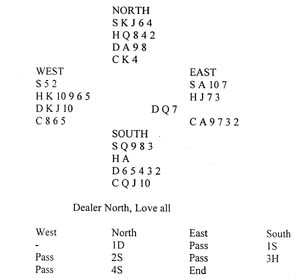|
Bridge
David Bird
 BOTH
sides did well to reach the spade game on this deal from an Olympiad
clash between the women’s teams of USA and Russia. Playing a strong
INT and five-card major, the USA North had to open ID. When her partner
made a short-suit game try on the second round, she leapt to 4S. West
led the 10 of hearts, won with the ace. How would you have played the
hand? It was necessary to establish a diamond discard on the club suit
before playing on trumps. A club to the king was won by East’s ace and
she found the best switch, to the diamond queen. Declarer won
immediately (there was a case for ducking, to break the defender’s
communications) and took one diamond discard on the clubs. When a trump
was played to the king and ace, East returned a diamond to West’s jack
and a third diamond was played. Declarer now had to guess who held the
10 of trumps. She guessed correctly by ruffing with the jerk in dummy,
subsequently finessing the trump 9. The play followed exactly the same
course at the other table. It’s hard work obtaining a flat board when
you play at such a high level. BOTH
sides did well to reach the spade game on this deal from an Olympiad
clash between the women’s teams of USA and Russia. Playing a strong
INT and five-card major, the USA North had to open ID. When her partner
made a short-suit game try on the second round, she leapt to 4S. West
led the 10 of hearts, won with the ace. How would you have played the
hand? It was necessary to establish a diamond discard on the club suit
before playing on trumps. A club to the king was won by East’s ace and
she found the best switch, to the diamond queen. Declarer won
immediately (there was a case for ducking, to break the defender’s
communications) and took one diamond discard on the clubs. When a trump
was played to the king and ace, East returned a diamond to West’s jack
and a third diamond was played. Declarer now had to guess who held the
10 of trumps. She guessed correctly by ruffing with the jerk in dummy,
subsequently finessing the trump 9. The play followed exactly the same
course at the other table. It’s hard work obtaining a flat board when
you play at such a high level.
What opening bid
would you make?
Answer
If you have some
ancient bridge text-book on your shelves you will find that it
recommends an opening bid of ID on hands such as these. ‘You will have
a comfortable rebid of 2C,’ it will tell you. The problem with this is
that partner will often give preference to diamonds when you would be
better off in clubs. Open IC and, over IH or IS, rebid INT (If this
shows a weak hand in your system). If you play a weak INT, popular in
New Zealand, rebid 2C.
Awards: IC-10, ID-6,
INT (weak)-5.
— Knight Features
|